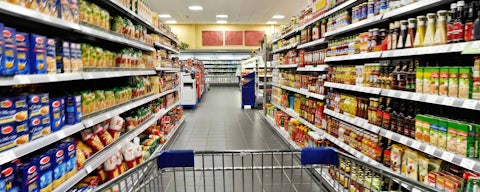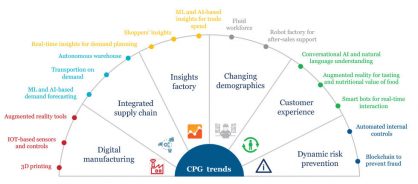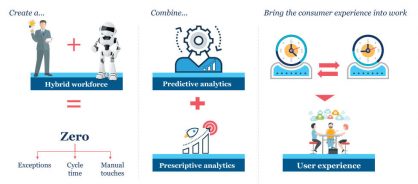- Point of view
How consumer goods firms move faster with digital finance
Exploring the digital future for finance

Large consumer and packaged goods (CPG) companies are hotbeds of innovation. They’re embracing digital technologies as they respond to changing consumer behaviors and find better ways of working – from robotics in manufacturing to artificial intelligence (AI) and machine learning (ML) creating insights in marketing and much more.
With disruptive competitors shifting the landscape, these technologies are helping CPG leaders transform their product and service lines. And while digital creates clear benefits for the customer experience, leading firms are also reimagining internal processes to make sure they have seamless operations, and can unlock revenue opportunities and stay ahead of the field.
Finance is no exception. Applied correctly, digital technologies in finance and accounting (F&A) can connect the organization across the front, middle, and back office, and with partners, suppliers, and customers too. Digital technologies also make F&A more valuable to the business, turning it into a provider of high-value insights and forward-looking intelligence that – if acted on – can help companies quickly adapt to changing customer demands, build on opportunities, and mitigate risk.
Digital trends in CPG
The Hershey Company is not alone. As more large enterprises use digital technologies to accelerate business results, the consumer-goods sector is becoming one of the most tech-forward industries.
Genpact’s analysis finds that companies are investing in up to 16 different digitization trends that are unique to the CPG industry. They include everything from 3D printing for manufacturing to smart bots for customer service (figure 1).
No process in the end-to-end CPG value chain – spanning sourcing, manufacturing, distribution, sales/marketing, and consumer interactions – has been left untouched by these trends. Common examples include:
- Automating processes or tasks: using physical robots for packaging and handling, or AI for talent screening in HR
- Working with external partners for cost optimization: using app-based, on-demand trucking for scalable distribution options or exploring blockchain for a faster, more seamless supply chain
- Improving the user experience: offering voice-tech shopping (like Amazon’s Alexa) to consumers or mobile apps for staff training
- Using data-driven insights for strategy: capturing customer behavior in-store or online, and applying AI or machine learning to inform trade-promotion strategies
Take a copy for yourself
In each of these scenarios, digital technology drives sales, creates competitive advantages, or improves efficiencies. Transforming F&A with digital solutions can accelerate and enhance those benefits.
Figure 1: Digital trends in the consumer goods industry

Taking finance further
It was 2001 when Jack Welch said that the biggest opportunity for big companies lay in the digitization of internal processes. But we believe that most major CPG firms are just beginning to realize the full potential.
F&A is an area of especially high opportunity. Compared to teams that connect directly with customers, many finance functions have been lower on enterprises’ priority lists for technology investment.
Those areas of F&A that have enjoyed strong digital adoption and investment to date – such as electronic invoicing – largely place paper-based processes online and still demand human effort for the actual work, such as validating invoices against contract terms for trade-promotion payments.
But that’s all changing. As the finance organization grows more central to business decision making, teams are investing in new digital areas – some of which can reimagine how F&A operates.
Companies are, for example, using automation and AI to transform trade-promotion processes. Digital technologies automate all aspects of the trade-promotion cycle spanning contract creation, invoice validation, proof-of-performance, and payment. For one CPG giant, we expect this to lead to a $21 million increase in net revenue annually from fewer overpayments and a 60% productivity gain across the end-to-end cycle.
Advanced analytics will help companies drive even more significant gains. As CPG firms become more agile in their operations, they are creating more data on their transactions with third parties – such as on-demand trucking providers or trade-promotion partners. When this information is captured by robust digital solutions with analytics and AI capabilities, companies can generate insights and intelligence into areas such as payment-on-time, spend history, or supplier ROI.
The future state of F&A
Digital finance delivers the agility CPG companies need to harness data, such as trade-promotion spend or social media data to understand consumer sentiment and inform strategies for growth and profitability.
Making F&A more structured and streamlined with digital allows transactions to become invisible or touchless, which reduces manual effort, and drives up accuracy and productivity. For example, we helped one global consumer goods manufacturer reduce reporting errors to <0.5% and reach near-real-time data analysis on many aspects of its value chain (shipments, sales, advertising, and more) by automating its master-data-management system.
Automating other complex tasks like statutory reporting can help finance enable a continuous close process in which it can close the books almost on demand. Dynamic risk prevention also minimizes the interventions when filing returns: AI can identify if there are missing fields or errors in tax calculations, for example, and flag them for resolution. It can even prescriptively auto-resolve them.
But the value extends much further than productivity gains and error reduction. As figure 2 shows, the future of F&A will be marked by:
- Growing adoption of a hybrid and fluid workforce. AI and robotic process automation are shifting how resources are used, which skills to develop, and how organizations manage teams of people and machines
- The exploding power of data analytics and insights inform business decisions, in part, by linking financial data to operational performance, providing insights on demand for a more complete understanding
- Increased emphasis on the interactive user experience. Mobile solutions and cloud-based systems, for example, deliver consumer-style interfaces that are more attractive and easier to use – helping lower errors and speed up processing times
As these developments take hold, they will help finance make a more powerful contribution to the business by providing predictive intelligence to inform strategic decisions.
Figure 2: The future of F&A with digital finance

The more robust the data and intelligence, the greater the potential for F&A to speed business results – guiding decisions that get products to customers more quickly, uncover new market opportunities, and help the business work more effectively. Ultimately, that kind of innovation is just as important to the future of a CPG business as product and distribution transformation.
CPG companies must become more agile to keep pace with increasingly disruptive competition. By streamlining and digitizing finance, collaborating internally and with partners, and creating a foundation for analytics and insights, CPG firms can act on opportunities faster – and pass the benefits on to their customers.
This point of view was authored by Vivek Saxena, Senior Vice President, Record to Report, Enterprise Performance Management, and Accounts Payable.
Visit our finance and accounting services page
1. Nunes, Keith, 'Hershey building a bridge to the future', Baking Business, August 30, 2018